NEW EDITION EVELINE CHAO DOVER PUBLICATIONS, INC. Mineola, New York
Copyright 2013 by Eveline Chao All rights reserved.
, first published in 2013, is a completely revised and updated work, which supersedes the book titled
, originally published by Dover Publications, Inc., in 1980.
Chao, Eveline. Say it in Chinese / Eveline Chao. p. cm. (Dover language guides Say it series) Summary: "Gets quickly to the heart of communication."The New York Times. (Dover language guides Say it series) Summary: "Gets quickly to the heart of communication."The New York Times.
Compact and comprehensive, this convenient reference features more than 1,600 numbered entries for every occasion. New contents include terms for modern technology, transportation, and communications. Contains essential information for travelers, a pronunciation guide, a supplement on Chinese food, and a 2,500-word English-Chinese dictionary"Provided by publisher. eISBN-13: 978-0-486-31571-3 ISBN-10: 0-486-48511-0 (pbk.) 1. Chinese languageConversation and
phrase booksEnglish. 2.
Chinese languageSpoken ChineseDictionariesEnglish. 3. Language and cultureChina. 4. ChinaLanguages. Title. Title.
PL1125.E6C44 2013 495.1'83421dc23 2013029024 Manufactured in the United States by Courier Corporation
48511001 2013
www.doverpublications.com
Quick & to the Point/Sidebars
Throughout the book, you will notice two types of shaded boxes. The Quick & to the Point sections summarize the most important words and phrases contained in the chapter. These essential and handy phrases provide the easiest and simplest communication that a traveler may need on any given topic. The other sidebars, which also appear in tinted boxes, contain interesting facts for the traveler. Pertinent to the theme of each chapter, the sidebars may inform readers about a unique aspect of the culture, feature special details about the language, or offer a bit of entertaining trivia.
SCHEME OF PRONUNCIATION
Mandarin Chinese is written with characters that require rote memorization to be learned.
To make things easier, students usually start out learning pinyin instead, which is a spelling system that represents Mandarin sounds using roman letters instead of characters. Chinese schoolchildren start out learning pinyin, too. Pinyin has its own pronunciation that must be learned; in other words, the syllables you see arent pronounced the way they would be pronounced according to regular English pronunciation rules. [Note that this book uses simplified Chinese characters, used throughout mainland China, and not traditional Chinese characters, which are used in Taiwan, Hong Kong, and Macau.] To make things easier, we have provided a phonetic pronunciation for each phrase in the book in italics, alongside the pinyin. Heres an example, using the pinyin transliteration for the Chinese words for English and Chinese. English. . Yngy. ing-yreeChinese.
. Yngy. ing-yreeChinese. . Zhngwn. johng-wen (note that, in this book, oh is meant to denote a long o sound) As you can see, the italics indicate the phonetic pronunciation. johng-wen (note that, in this book, oh is meant to denote a long o sound) As you can see, the italics indicate the phonetic pronunciation.
. Zhngwn. johng-wen (note that, in this book, oh is meant to denote a long o sound) As you can see, the italics indicate the phonetic pronunciation. johng-wen (note that, in this book, oh is meant to denote a long o sound) As you can see, the italics indicate the phonetic pronunciation.
However, there is another component in the pinyin that the italics do not include, which needs to be understood: tone marks. Tones are the most difficult aspect of Mandarin pronunciation to master. There are four tones, usually described as follows: First tone: This is a high, level tone. It doesnt matter how low or high your natural voice is, just how you hold the various tones relative to yourself. This should be a sustained, unchanging sound held at the higher end of your default voice range. Second tone: This is the rising tone. Second tone: This is the rising tone.
It should start at the middle of your voice range and rise toward the level of First tone. Its comparable to the way your voice rises when you say Huh? or What?! in response to something surprising. The tone mark for Second tone looks like this: m. Third tone: This is a dipping toneit starts near the bottom of your voice range, dips lower, then rises towards the end, similar to Second tone. The tone mark looks like this: m. Fourth tone: This is a downward-falling tone and sounds like someone saying something emphatic and curt, like No! or Stop! It looks like this: m.
There is a so-called Fifth tone, also known as neutral tone, which applies to syllables that appear at the end of a word or sentencethe sound gets pronounced so quickly or trails off in such a way that there is no time to give it a real, full expression. You may think of this as sounding similar to the way you mumble Hm when half-listening to somebodynot quite a full sound. Syllables pronounced with the neutral tone throughout this book have no tone marks written on them: ma.
How to Use This Book
The tone marks provided throughout this book are not necessarily the tone marks you would find for the words in a dictionary. Instead, we have marked the sentences such that they reflect the way the characters would be pronounced in real life. For example, the character for no or negation,

, always appears with a Fourth tone in a dictionary: b.
However, in speaking, it is usually pronounced with Second tone when it appears in front of another syllable with Fourth tone, because the phrase simply sounds better that way.
EVERYDAY EXPRESSIONS
Useful Phrases. chngyng biod fngsh. chong-yohng byow-dah fong-shih1. Hello. Goodbye.
chngyng biod fngsh. chong-yohng byow-dah fong-shih1. Hello. Goodbye.
Nho.
Nee-how. Nee-how.
Dzie-jinn2. Have you eaten? (polite stock greeting)  Ch fnle ma? Chih fahn-luh mah?3. Long time no see.
Ch fnle ma? Chih fahn-luh mah?3. Long time no see. Hojibjin. How-joe-boo-jinn4. Good morning. Good afternoon.
Hojibjin. How-joe-boo-jinn4. Good morning. Good afternoon.
Good evening. Good night. Zoshang ho. Xiw ho. Wnshang ho. Wnn. Dzow-shong-how.
Zoshang ho. Xiw ho. Wnshang ho. Wnn. Dzow-shong-how.
Shyah-oo-how. Wahn-shung-how. Won-ahn5. How are you? (to greet someone you know)  Nho ma? / N znmeyng? Nee-how mah? / Nee dzuh-muh yahng?6. Im ok, how are you?
Nho ma? / N znmeyng? Nee-how mah? / Nee dzuh-muh yahng?6. Im ok, how are you? Hi ho, n ne? High-how, nee-nuh?7. Boo-tswuh8. Boo-tswuh8.
Hi ho, n ne? High-how, nee-nuh?7. Boo-tswuh8. Boo-tswuh8.


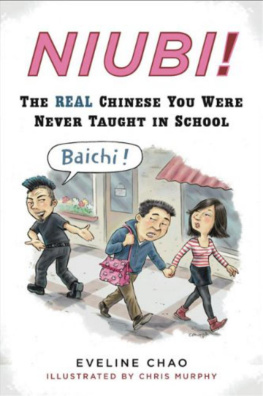

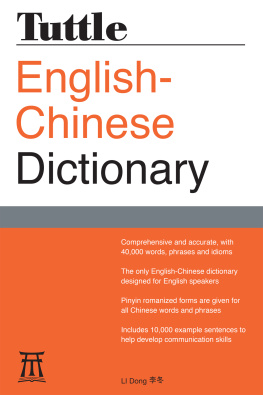
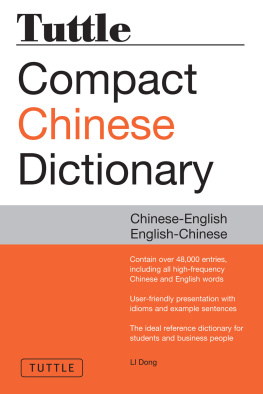

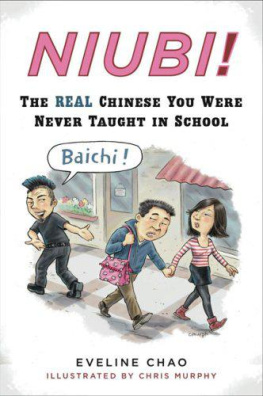
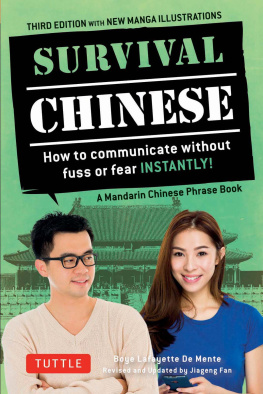

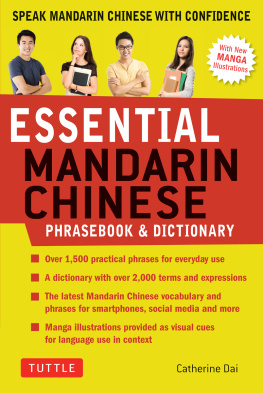


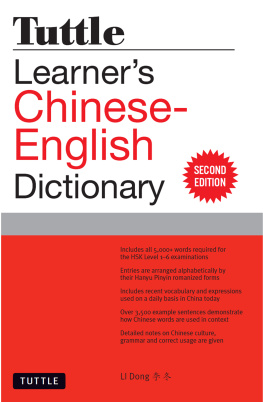

 . Yngy. ing-yreeChinese.
. Yngy. ing-yreeChinese. . Zhngwn. johng-wen (note that, in this book, oh is meant to denote a long o sound) As you can see, the italics indicate the phonetic pronunciation. johng-wen (note that, in this book, oh is meant to denote a long o sound) As you can see, the italics indicate the phonetic pronunciation.
. Zhngwn. johng-wen (note that, in this book, oh is meant to denote a long o sound) As you can see, the italics indicate the phonetic pronunciation. johng-wen (note that, in this book, oh is meant to denote a long o sound) As you can see, the italics indicate the phonetic pronunciation. , always appears with a Fourth tone in a dictionary: b.
, always appears with a Fourth tone in a dictionary: b.  chngyng biod fngsh. chong-yohng byow-dah fong-shih1. Hello. Goodbye.
chngyng biod fngsh. chong-yohng byow-dah fong-shih1. Hello. Goodbye. Nho. Nee-how. Nee-how.
Nho. Nee-how. Nee-how. Ch fnle ma? Chih fahn-luh mah?3. Long time no see.
Ch fnle ma? Chih fahn-luh mah?3. Long time no see. Hojibjin. How-joe-boo-jinn4. Good morning. Good afternoon.
Hojibjin. How-joe-boo-jinn4. Good morning. Good afternoon. Zoshang ho. Xiw ho. Wnshang ho. Wnn. Dzow-shong-how.
Zoshang ho. Xiw ho. Wnshang ho. Wnn. Dzow-shong-how. Nho ma? / N znmeyng? Nee-how mah? / Nee dzuh-muh yahng?6. Im ok, how are you?
Nho ma? / N znmeyng? Nee-how mah? / Nee dzuh-muh yahng?6. Im ok, how are you? Hi ho, n ne? High-how, nee-nuh?7. Boo-tswuh8. Boo-tswuh8.
Hi ho, n ne? High-how, nee-nuh?7. Boo-tswuh8. Boo-tswuh8.